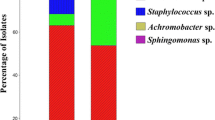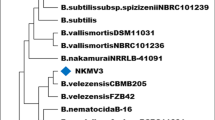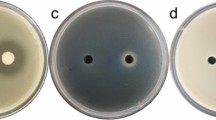Abstract
Walnut blight caused by Xanthomonas arboricola pv. juglandis (Xaj) is an important bacterial disease for walnut production worldwide. The objective of the present study was to characterize one endophytic bacterium, namely OFE17 from Osmanthus fragrans leaves, evaluate its potential biocontrol efficiency against the disease, and identify the underlying probable mechanisms of its function. Based on morphology, biochemical and physiological characteristics, 16S-rDNA and gyrB sequences, and antibiotic production genes, the endophyte OFE17 was tentatively identified as Bacillus sp. A disease control efficiency of up to 68.69% was observed through a biocontrol test on detached immature walnut fruits under controlled conditions. OFE17 can produce protease, cellulase, amylase, siderophores, and demonstrates phosphate dissolving ability. However, the OFE17 is unable to produce extracellular lipase, IAA (indoleacetic acid), and has no nitrogen fixation capability. The active compounds of OFE17 were primarily non-protein compounds, and the optimum organic extraction solvent was chloroform. Through specific PCR detection, it contains the genes ituA and ituD which play a key role in active compound synthesis of iturin A synthetase. This study added a promising biocontrol agent candidate for the disease control and laid a foundation for further exploration.






Similar content being viewed by others
Data availability
The sequences were deposited in NCBI. The strains are available for scientific research use only by request from the corresponding author Dr. Fu’s consent.
References
Anyasi RO, Atagana HI (2019) Endophyte: understanding the microbes and its applications. Pakistan J Biol Sci 22:154–167
Belisario A, Maccaroni M, Corazza L et al (2002) Occurrence and etiology of brown apical necrosis on Persian (English) walnut fruit. Plant Dis 86:599–602. https://doi.org/10.1094/PDIS.2002.86.6.599
Buchner RP, Olson WH, Adaskaveg JE (2001) Walnut blight (Xanthomonas campestris pv. juglandis) control investigations in northern california, USA. In: Acta Hortic. pp 369–378
Burokiene D, Pulawska J (2012) Characterization of Xanthomonas arboricola pv. juglandis isolated from walnuts in Lithuania. J Plant Pathol 94:S1.23-S1.27. https://doi.org/10.4454/jpp.v94i1sup.005
Chen H, Yuan C, Cai K et al (2008) Purification and identification of iturin A from Bacillus subtilis JA by electrospray ionization mass spectrometry. Wei Sheng Wu Xue Bao = Acta Microbiologica Sinica 48:116–120
de Almeida Lopes KB, Carpentieri-Pipolo V, Fira D et al (2018) Screening of bacterial endophytes as potential biocontrol agents against soybean diseases. J Appl Microbiol 125:1466–1481. https://doi.org/10.1111/jam.14041
Dömötör D, Frank T, Rákhely G et al (2016) Comparative analysis of two bacteriophages of Xanthomonas arboricola pv. juglandis. Infection, Gene Evol 43:371–377. https://doi.org/10.1016/j.meegid.2016.06.011
Dong X, Cao M (2001) Common Bacterial System Identification Manual. Science Press, Beijing
Ek-Ramos MJ, Gomez-Flores R, Orozco-Flores AA et al (2019) Bioactive products from plant-endophytic Gram-positive bacteria. Front Microbiol 10. https://doi.org/10.3389/fmicb.2019.00463
Eljounaidi K, Lee SK, Bae H (2016) Bacterial endophytes as potential biocontrol agents of vascular wilt diseases – Review and future prospects. Biological Control 62–68
Fang X, Qin K, Li S et al (2020) Whole genome sequence of Diaporthe capsici, a new pathogen of walnut blight. Genomics 112:3751–3761. https://doi.org/10.1016/j.ygeno.2020.04.018
Frutos D (2010) Bacterial diseases of walnut and hazelnut and genetic resources. J Plant Pathol 92:S1.79-s1.85
Frutos D, López G (2012) Search for Juglans regia genotypes resistant/tolerant to Xanthomonas arboricola pv. juglandis in the framework of COST Action 873. J Plant Pathol 94:S1.37-S1.46. https://doi.org/10.4454/jpp.v94i1sup.007
Fu B, Chen Q, Wei M et al (2018) Complete genome sequence of Xanthomonas arboricola pv. juglandis strain DW3F3, isolated from a Juglans regia L. bacterial blighted fruitlet. Genome Announce 6(8):e00023–18. https://doi.org/10.1128/genomeA.00023-18
Fu B, Qianqian C, Wei M et al (2016) Investigation of walnut bacterial blight pathogens based on 16S-rDNA sequences and RFLP. J Agric Univ Heibei 39:63–68
Ginibre T, Prunet JP, Station C (2001) Chemical control of bacterial blight of walnut, three years of results. Acta Horticulturae. 409–412
Giovanardi D, Bonneau S, Gironde S et al (2016) Morphological and genotypic features of Xanthomonas arboricola pv. juglandis populations from walnut groves in Romagna region. Italy Euro J Plant Pathol 145:1–16. https://doi.org/10.1007/s10658-015-0809-2
Hajri A, Meyer D, Delort F et al (2010) Identification of a genetic lineage within Xanthomonas arboricola pv. juglandis as the causal agent of vertical oozing canker of Persian (English) walnut in France. Plant Pathol 59:1014–1022. https://doi.org/10.1111/j.1365-3059.2010.02362.x
Hossain MT, Chung YR (2019) Endophytic Bacillus Species Induce Systemic Resistance to Plant Diseases. In: Bacilli and Agrobiotechnology: Phytostimulation and Biocontrol. pp 151–160
Islam MN, Ali MS, Choi SJ et al (2019) Biocontrol of citrus canker disease caused by Xanthomonas citri subsp. citri using an endophytic Bacillus thuringiensis. Plant Pathol J 35:486–497. https://doi.org/10.5423/PPJ.OA.03.2019.0060
Kaluzna M, Pulawska J, Waleron M, Sobiczewski P (2014) The genetic characterization of Xanthomonas arboricola pv. juglandis, the causal agent of walnut blight in Poland. Plant Pathol 63:1404–1416. https://doi.org/10.1111/ppa.12211
Kamber T, Lansdell TA, Stockwell VO et al (2012) Characterization of the biosynthetic operon for the antibacterial peptide herbicolin in Pantoea vagans biocontrol strain C9–1 and incidence in Pantoea species. Appl Environ Microbiol 78:4412–4419. https://doi.org/10.1128/AEM.07351-11
Kim HS, Lee DH, Lee SK et al (2020) First report of walnut blight canker on walnut tree (Juglans regia) by Pseudomonas flavescens in South Korea. J Plant Pathol 943
Lamichhane JR (2014) Xanthomonas arboricola diseases of stone fruit, almond, and walnut Trees: progress toward understanding and management. Plant Dis 98:1600–1610. https://doi.org/10.1094/PDIS-08-14-0831-FE
Larran S, Simón MR, Moreno MV et al (2016) Endophytes from wheat as biocontrol agents against tan spot disease. Biologic Control 92:17–23. https://doi.org/10.1016/j.biocontrol.2015.09.002
Lee YA, Hendson M, Panopoulos NJ, Schroth MN (1994) Molecular cloning, chromosomal mapping, and sequence analysis of copper resistance genes from Xanthomonas campestris pv. juglandis: Homology with small blue copper proteins and multicopper oxidase. J Bacteriol 176:173–188
Li H, Ruan G, Li Z, Yu Y (2014) Isolation, antioxidant and antibacterial activities of endophytic fungi from Osmanthus fragrans. J Guilin Univ Technol 34:138–145. https://doi.org/10.3969/j.issn.1674-9057
Lin Y, Du D, Si C et al (2014) Potential biocontrol Bacillus sp. strains isolated by an improved method from vinegar waste compost exhibit antibiosis against fungal pathogens and promote growth of cucumbers. Biological Control 71:7–15. https://doi.org/10.1016/j.biocontrol.2013.12.010
Liu B, Qiao H, Huang L et al (2009) Biological control of take-all in wheat by endophytic Bacillus subtilis E1R-j and potential mode of action. Biological Control 49:277–285. https://doi.org/10.1016/j.biocontrol.2009.02.007
Liu C, Tingting L, Fengfeng Y, Gu Y (2010) Isolating endophytic fungi from evergreen plants and determining their antifungal activities. African J Microbiol Res 4:2243–2248
Liu X, Yao Z, Shim JM et al (2017) Properties of antimicrobial substances produced by Bacillus species isolated from rice straw. Korean J Microbiol Biotechnol 45:133–142. https://doi.org/10.4014/mbl.1611.11004
Massawe VC, Hanif A, Farzand A et al (2018) Volatile compounds of dndophytic Bacillus spp. have biocontrol activity against Sclerotinia sclerotiorum. Phytopathology 108:1373–1385. https://doi.org/10.1094/PHYTO-04-18-0118-R
McNeil DL, Romero S, Kandula J et al (2001) Bacteriophages a potential biocontrol agent against walnut blight (Xanthomonas campestris pv juglandis). New Zealand Plant Protect 54:220–224. https://doi.org/10.30843/nzpp.2001.54.3743
Moragrega C, Matias J, Aletà N et al (2011) Apical necrosis and premature drop of Persian (English) walnut fruit caused by Xanthomonas arboricola pv. juglandis. Plant Dis 95:1565–1570. https://doi.org/10.1094/PDIS-03-11-0259
Moragrega C, Özaktan H (2010) Apical necrosis of Persian (English) walnut (Juglans regia): an update. J Plant Pathol 92:67–71. https://doi.org/10.4454/jpp.v92i1sup.2507
Moretti C, Buonaurio R (2010) Immature walnut fruit inoculation for evaluation of Brenneria nigrifluens pathogenicity. Phytopathologia Mediterranea 49:80–83. https://doi.org/10.14601/Phytopathol_Mediterr-3112
Muangthong A, Youpensuk S, Rerkasem B (2015) Isolation and characterisation of endophytic nitrogen fixing bacteria in sugarcane. Tropical Life Sci Res 26:41–51
Nautiyal CS (1999) An efficient microbiological growth medium for screening phosphate solubilizing microorganisms. FEMS Microbiol Let 170:265–270. https://doi.org/10.1016/S0378-1097(98)00555-2
Ninot A, Aletà N, Moragrega C, Montesinos E (2002) Evaluation of a reduced copper spraying program to control bacterial blight of walnut. Plant Dis 86:583–587. https://doi.org/10.1094/PDIS.2002.86.6.583
Ouyang M, Sun H, Mo X et al (2012) Screening of lipase production bacteria and optimization of the lipase production. Biotechnol Bull 111–116
Ozaktan H, Erdal M, Akkopru A, Aslan E (2012) Biological control of bacterial blight of walnut by antagonistic bacteria. J Plant Pathol 94:S1.53-S1.56
Palacio-Bielsa A, Pothier JF, Roselló M et al (2012) Detection and identification methods and new tests as developed and used in the framework of cost873 for bacteria pathogenic to stone fruits and nuts: Tumorigenic agrobacterium spp. J Plant Pathol 94:97–104. https://doi.org/10.4454/jpp.v94i1sup.016
Pereira UP, Gouran H, Nascimento R et al (2015) Complete genome sequence of Xanthomonas arboricola pv. juglandis 417, a copper-resistant strain isolated from Juglans regia L. Genome Announce 3:13–14. https://doi.org/10.1128/genomeA.01126-15
Pierce NB (1901) Walnut bacteriosis. Botanical Gazette 31:272–273. https://doi.org/10.1086/328100
Rahman A, Sitepu IR, Tang SY, Hashidoko Y (2010) Salkowski’s reagent test as a primary screening index for functionalities of rhizobacteria isolated from wild dipterocarp saplings growing naturally on medium-strongly acidic tropical peat soil. Biosci, Biotechnol Biochem 74:2202–2208. https://doi.org/10.1271/bbb.100360
Retamales J, Vasquez I, Santos L et al (2016) Complete genome sequences of lytic Bacteriophages of Xanthomonas arboricola pv. juglandis. Genome Announce 4. https://doi.org/10.1128/genomeA.00336-16
Romero FM, Rossi FR, Gárriz A et al (2019) A bacterial endophyte from apoplast fluids protects canola plants from different phytopathogens via antibiosis and induction of host resistance. Phytopathology 109:375–383. https://doi.org/10.1094/PHYTO-07-18-0262-R
Rong S, Xu H, Li L et al (2020) Antifungal activity of endophytic Bacillus safensis B21 and its potential application as a biopesticide to control rice blast. Pest Biochem Physiol 162:69–77. https://doi.org/10.1016/j.pestbp.2019.09.003
Schulz B, Boyle C (2007) What are Endophytes? In: Microbial Root Endophytes. pp 1–13
Scotton M, Bortolin E, Fiorin A, Belisario A (2015) Environmental and pathogenic factors inducing Brown Apical Necrosis on fruit of English (Persian) Walnut. Phytopathology 105:1427–1436
Shi L, Li Y, Li G et al (2017) Screening of high yield cellulase Bacillus subtilis S-16 and optimization of its fermentation process. Biotic Resourc 39:118–124
Silva-Stenico ME, Pacheco FTH, Rodrigues JLM et al (2005) Growth and siderophore production of Xylella fastidiosa under iron-limited conditions. Microbiologic Res 160:429–436. https://doi.org/10.1016/j.micres.2005.03.007
Soltani J, Aliabadi AA (2013) Antibacterial effects of several plant extracts and essential oils on Xanthomonas arboricola pv. juglandis in vitro. J Essential Oil Bear Plants 16:461–468. https://doi.org/10.1080/0972060X.2013.813246
Sun H, Li H, Zhan YG, Li Y (2018) Phyllosphere bacterial community structure of Osmanthus fragrans and Nerium indicum in different habitats. Chinese J Appl Ecol 29:1653–1659. https://doi.org/10.13287/j.1001-9332.201805.036
Trivedi P, Spann T, Wang N (2011) Isolation and characterization of beneficial bacteria associated with citrus roots in Florida. Micro Ecol 62:324–336. https://doi.org/10.1007/s00248-011-9822-y
Vauterin L, Hoste B, Kersters K, Swings J (1995) Reclassification of Xanthomonas. Intern J System Bacteriol 45:472–489. https://doi.org/10.1099/00207713-45-3-472
Wang J, Chen Z, Liu Y, Lu F (2014) Screening,identification and characterization of an acid α-amylase producing strain and optimization of its fermentable condition. Biotechnol Bull 159–163
Wang LT, Lee FL, Tai CJ, Kasai H (2007) Comparison of gyrB gene sequences, 16S rRNA gene sequences and DNA-DNA hybridization in the Bacillus subtilis group. Intern J System Evolution Microbiol 57:1846–1850. https://doi.org/10.1099/ijs.0.64685-0
Xiong H, Li Y, Cai Y et al (2015) Isolation of Bacillus amyloliquefaciens JK6 and identification of its lipopeptides surfactin for suppressing tomato bacterial wilt. RSC Adv 5:82042–82049. https://doi.org/10.1039/c5ra13142a
Xu W, Ren H, Ou T et al (2019) Genomic and functional characterization of the endophytic Bacillus subtilis 7PJ-16 Strain, a potential biocontrol agent of mulberry fruit Sclerotiniose. Micro Ecol 77:651–663. https://doi.org/10.1007/s00248-018-1247-4
Zarei S, Taghavi SM, Banihashemi Z et al (2019) Etiology of leaf spot and fruit canker symptoms on stone fruits and nut trees in Iran. J Plant Pathol 101:1133–1142. https://doi.org/10.1007/s42161-019-00283-w
Zhao D, Niu G, Peng Z et al (2010) Isolation and identification of five Bacillus subtilis strains in Wuliangye wrapped starter. China Brew 65–68
Funding
The work was supported by the Central-guided Local Project of Science & Technology Development (No.2019ZYYD045).
Author information
Authors and Affiliations
Contributions
B. Fu conceived and designed the work, L. Zou and B. Fu carried out the experiment. B. Fu and C. Lee prepared the manuscript, L. Wang supported the research and revised the manuscript, and all authors read and approved the final manuscript.
Corresponding author
Ethics declarations
Consent for publication
The authors are consent to publication of the manuscript in the Journal of Plant Pathology.
Competing interests
The authors declare that there are no conflicts of interest.
Additional information
Publisher's Note
Springer Nature remains neutral with regard to jurisdictional claims in published maps and institutional affiliations.
Rights and permissions
About this article
Cite this article
Fu, B., Zou, L., Lee, C. et al. Antagonism and biocontrol of walnut blight by sweet osmanthus endophytic bacterium OFE17. J Plant Pathol 103, 1243–1252 (2021). https://doi.org/10.1007/s42161-021-00901-6
Received:
Accepted:
Published:
Issue Date:
DOI: https://doi.org/10.1007/s42161-021-00901-6




